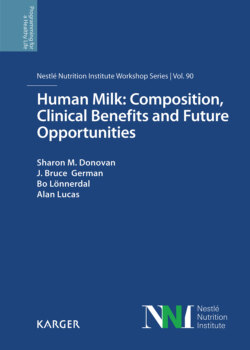Читать книгу Human Milk: Composition, Clinical Benefits and Future Opportunities - Группа авторов - Страница 35
На сайте Литреса книга снята с продажи.
Introduction
ОглавлениеFor the best part of four centuries, the medical world was secure in its view of how babies fed and removed milk from the breast – the terms “sucking” and “suckling” became mutually replaceable, even though they describe separate processes. Two commonly accepted facts remain today: first, the baby generates high levels of suction pressure in the oral cavity, so that any object placed in a baby’s mouth (bottle-teat, finger, pacifier) cannot easily be removed. Second, the baby’s tongue moves in a wave-like manner, with positive pressure being exerted rhythmically by the dorsum of the tongue surface to the underside of the nipple/breast complex held in the baby’s mouth; this is regarded as a type feature of the baby, taken to indicate its neurodevelopmental maturity.
The latter tongue movements, originally identified by practical observation [1–3], were later visualized using various techniques including cineradiography [4], 2D ultrasound [5, 6], direct filming [7] and, most recently, 3D ultrasound [8]. All such methods were unambiguous in observing peristaltic tongue movements (PTMs), on the basis of which it was assumed that they played a role in expressing milk from the breast; we have since confirmed that this collective view is essentially correct [9, 10].
Two studies, principally Eishima [7] and Geddes et al. [11], identified a novel feature of infant feeding, involving a localized drawing down of the central region of the tongue, adjacent to the nipple tip. To this movement was imputed the ability to generate increased (added) suction at the nipple surface, claimed to play a predominant role in milk extraction from the breast; subsequent studies have extended and elaborated on these claims [12–14]. We can similarly confirm that these authors are correct in their observations, and in their proposition that the action aids milk extraction; nonetheless, some vital caveats need to be considered when evaluating the full validity of their claims.
